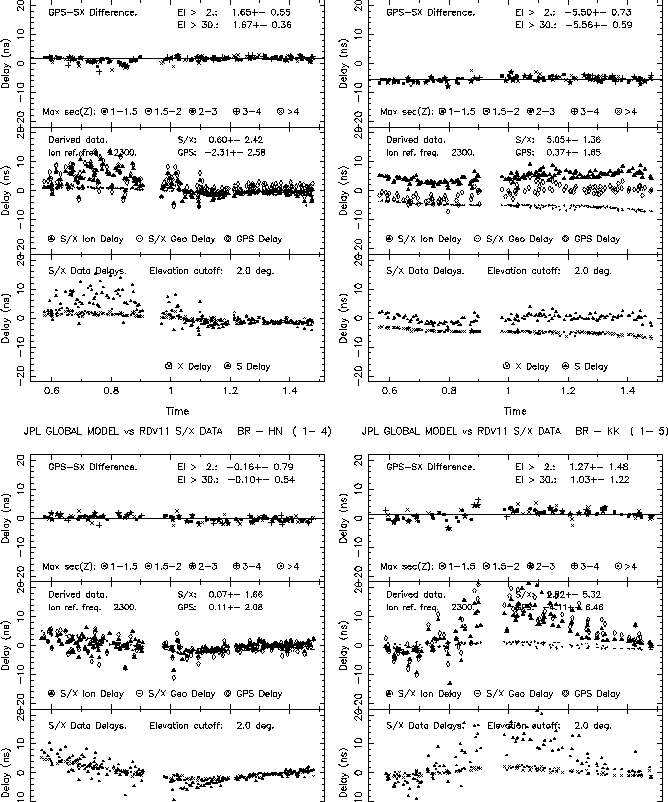RDV11 Results
Next: TP015 Phase Referenced Imaging Up: VLBA SCIENTIFIC MEMO 23 Previous: Direct Comparison of Delays
RDV11 Results
Figure 7 shows data from 4 baselines from the RDV11 global geodesy observation (the first 4 by alphabetical order). For each baseline, three panels are shown. The bottom panel shows the fitted multi-band delays for S and X bands. The middle panel shows the ionospheric and non-dispersive (``Geo'') delay derived from the S and X band delays. Also the ionospheric delay derived from a global model, the JPL model in this case, is shown (``GPS Delay''). The top panel is the difference between the S/X and GPS model ionospheric delays. Information printed within the second panel gives the average delays and scatter for the S/X and GPS ionospheric delays. Similar information in the top panel gives the average value and scatter for the S/X - GPS difference. Note that there is an arbitrary DC offset because of the unknown offset between S and X band receivers in the VLBI data, as described earlier. Pay closest attention to the scatters. Note that the stations in the figure are the Brewster WA VLBA site (BR), the Fort Davis TX VLBA site (FD), the Gill Creek AK geodetic site (GC -- near Fairbanks Alaska), The Hancock NH VLBA site (HN), and the Kokee Park HI geodetic site (KK -- on Kauai in Hawaii). The apparent large, short term, scatter in raw data is a result of scheduling short scans on sources all over the sky. The scatter represents the differences along the line-of-sight for observations at different elevations and azimuths.
 |
There are a few things to notice. First, the ionospheric delay is clearly much larger at S band than at X band, as expected. Delays of 10-20 ns are common. This is much larger than any other source of variable delay offsets at that band. There is a strong diurnal effect, also as expected. There is a strong latitude dependent effect, which is expected, but perhaps not widely appreciated. This can be seen by contrasting the BR-GC baseline (both high latitude) results with the BR-KK baseline (one low latitude station). It is also clearly seen in the GPS model data.
The GPS model does not give perfect correction of the data, but is much better than making no correction. Typically the scatter in the S/X-GPS difference is 2 to 5 times smaller than the scatter in the raw S band delays or in the S/X derived ionospheric delays.
Next: TP015 Phase Referenced Imaging Up: VLBA SCIENTIFIC MEMO 23 Previous: Direct Comparison of Delays Craig Walker
2000-03-16




Connect with NRAO